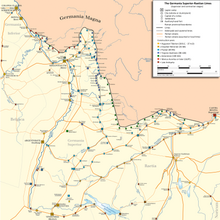Borbetomagus
Borbetomagus , more rarely Bormitomagus , is the Latinized name of a Celtic settlement on the site of today's city of Worms in Rheinhessen ( Rhineland-Palatinate ). Both spellings have been handed down.

Names
"Worms"
The Latin name of the settlement is of Celtic origin, although the Celtic name has been lost and only the Latin form has survived. The Latinized Celtic word for "field, level, market" has been preserved in the ending -magus . The place name was therefore often translated as "field on the Bormita".
According to one possible interpretation , Borbeto- can be traced back to the Celtic root word for * borvo-, * borbo- , which can also be found in the name of the bath god Borvo or Bormo . The place would be named after a healing spring or the corresponding god. The root word could have meant "liquid" or "warm spring". The Celtic word * borba , which has survived in various languages, also contains meanings such as “dirt” and “rubbish”. This could be an indication of the location of the city in the water-rich and swampy area between the mouths of the Eisbach and the Pfrimm into the Rhine .
Another interpretation of Borbeto- is to look for the origin in the Indo-European word root * bher- (“to wake up”), which also includes * bherm (“bubbling water”). Originally, Borbetomagus could also have meant "Quellenfeld".
By a subsequent sound change the anlautende was B to W . So Borbetomagus changed in the language of the Germanic settlers in the early Middle Ages to "Warmazfeld, Warmazia / Varmacia, Wormazia / Wormatia" and finally to "Worms". The fact that only the first syllable remained is due to the stress on this first syllable in Germanic, which was in contrast to the Latin stress.
"Wonnegau"
When the Romans came to the area of Worms at the turn of the Christian era , the Celtic population was probably in decline or even no longer existed. Therefore, the Romans promoted the settlement of the Germanic tribe of the Vangions here and set up a civitas , a semi-autonomous Roman administrative unit, under the name Civitas Vangionum . In the course of the following centuries the name was changed and is now preserved in the word Wonnegau for the area around Worms.
history
From the Augustan period (31 BC – 14 AD) only a few terra sigillata fragments are known in the Worms area . Nevertheless, Worms is being discussed as the oldest city in Germany . Since the Tiberian period (14–37) at the latest , as a result of the stationing of various auxiliary units - u. a. the mounted troops of the ala prima Hispanorum, ala Sebosiana , ala Agrippiana , ala Indiana - a Roman camp with a civilian settlement ( vicus ) to safely accept. The gravestones of the auxiliary soldiers, which are housed in the Museum of the City of Worms in the Andreasstift , bear witness to the presence of various troops on the Roman Rhine Valley Road .
After the troops were moved forward from the Rhine to the Neckar-Odenwald-Limes , Worms was the civil capital of the already existing Civitas Vangionum. In addition to the road network, structures in the cathedral area are known which belonged to the forum and a Jupiter temple. Several pottery kilns have been excavated in the south of the city; The Worms face jugs were made here in the vicinity of a brick factory in the neighborhood . The most important finds, however, come from the Roman graves; Research results on this were presented comprehensively in 2006.
In late antiquity, Worms again became a border town after the fall of the Limes; the milites secundae Flaviae were stationed in the fort . The late antique city wall , which is still partially preserved at the Pauluskirche and northwest of the cathedral area, probably dates from the Valentine period (364–375) .
It is discussed whether Borbetomagus was the seat of the Burgundian Empire on the Upper Rhine in the early 5th century .
See also
List of forts in the Danube-Iller-Rhein-Limes
literature
- Heinz Cüppers (Ed.): The Romans in Rhineland-Palatinate . Stuttgart 1990. pp. 673-679
- Albrecht Greule and others: Keyword Worms . In: Heinrich Beck et al. (Hrsg.): Reallexikon der Germanischen Altertumskunde . 2nd edition, Volume 34. Berlin 2007. pp. 225 ff.
- Mathilde Grünewald: The Romans in Worms . Stuttgart 1986
- Mathilde Grünewald, Erwin Hahn: Between the Varus Battle and the Migration Period. The Roman grave finds from Worms and Rheinhessen in the Museum of the City of Worms in the Andreasstift . Lindenberg 2006
- Maximilian Ihm : Borbetomagus . In: Paulys Realencyclopadie der classischen Antiquity Science (RE). Volume III, 1, Stuttgart 1897, Col. 719 f.
Web links
Individual evidence
- ^ Gerhard Rasch: Ancient geographical names north of the Alps . Verlag Walter de Gruyter, 2005. ISBN 978-3-11-017832-6 . P. 140
- ^ Franz Cramer: Rhenish place names from pre-Roman and Roman times . Sänd Verlag, 1970 (reprint from 1901). ISBN 3500216501 . P. 8
- ↑ Bernhard Maier : Small lexicon of names and words of Celtic origin. CH Beck OHG, Munich 2003, 122. ISBN 3-406-49470-6 . ( On google books )
- ^ Xavier Delamarre: Dictionnaire de la langue gauloise . Errance 2003. pp. 82-83
- ↑ Johannes Kramer (Ed.): Etymological Dictionary of the Dolomites Ladin (EWD) . Buske Verlag, 1988. ISBN 3-87118991-X . P. 320
- ^ Oswald Szemerényi: Introduction to comparative linguistics . Scientific Book Society, 1980. ISBN 3-534042166 . P. 111
- ↑ Journal for Celtic Philology ( Memento of the original from July 14, 2014 in the Internet Archive ) Info: The archive link has been inserted automatically and has not yet been checked. Please check the original and archive link according to the instructions and then remove this notice. , No. 52. Max Niemeyer Verlag, 2001. p. 163
- ↑ M. Grünewald, E. Hahn (see literature )

